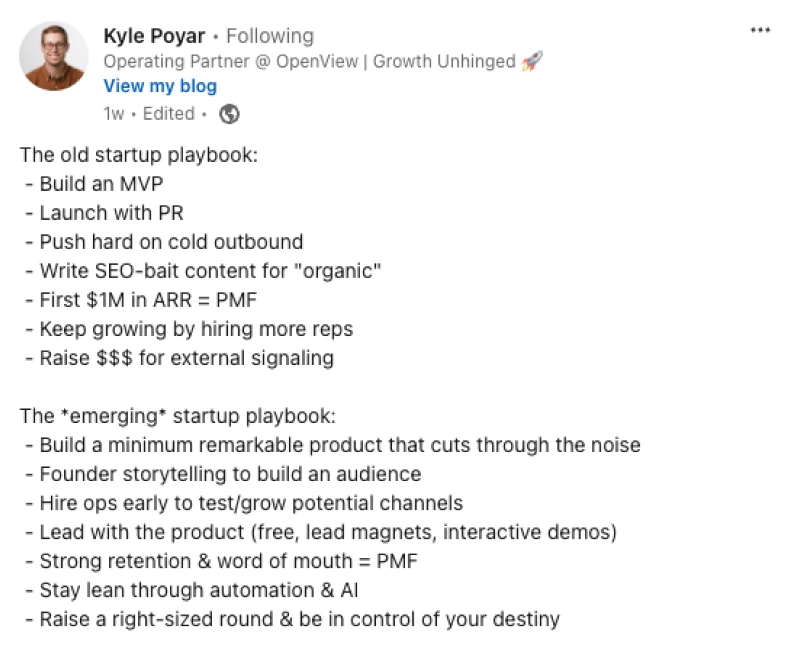An introduction into the world of founder led sales and how to navigate its challenges. Written by whomso, with examples of how we did it.
Introduction
Founder led sales is the go-to-market motion of the moment. And rightly so. People care about the story behind a company and who better to tell that story than the individual(s) who took it from 0-to-1?
I’ve done my fair share of founder led sales and so I’m going to do my best to explain what makes it so valuable and what you need to get started.

Understanding the founder role in sales
Every founder needs to have a hand in sales. It’s not really negotiable. It might be light touch product-led sales, or it might be enterprise sales - it doesn’t really matter, there just needs to be some involvement.
The reason for this - unless you’re a blue ocean product - is you’re competing with companies much bigger than yourself. You need that personal touch that the reps at Atlassian, or Snowflake, or Salesforce just can’t replicate.
As the founder, you should also hold intense conviction about your company and its mission and be able to articulate this to your prospects. Try asking the sales team at Google to do that.
The point is that founder led sales works so well because it adds a dimension of personality that will differentiate you when you’re unable to compete on pricing or features.
Fitting into the role
If you’re new to sales then cultivating the right mindset is initially going to be tough. I’m not going to sugarcoat it.
I’d been working as a product manager prior to starting whomso and hadn’t led a sales call in my life, least of all closed anybody. But ironically the hardest thing for me to wrap my head around was outbound.
Personally, it was the constant rejection. I’d dealt with my fair share of irate customers before but the sting of yet another no was a real ego blow.
But it’s what every founder needs to experience at some point to develop a sales mindset. Being able to push aside the opinions of others and move onto the next deal is a super power in the early days.
A quick tip that I used to make sales seem less daunting was to try reframing it as a search. You’re not selling to prospects - you’re searching for people that might be experiencing the problem you solve. It sounds maybe a bit too simple but if you repeat it enough times it really does help. This is especially helpful if you’re from a product background since it’s what most PMs are used to!
Getting initial sales
The most obvious place to get started is by leveraging your personal network. It's the path of least resistance and offers a slightly more cushioned landing into sales, so I'd highly recommend it.
Now, unless you live in the Bay Area or regularly visit networking events, you're probably not going to get your biggest deals from this category, but it doesn't matter. You just need to get the engine going and start selling something.
Trawl your LinkedIn and find anyone with a fitting title to reach out to. And if they’re the wrong fit, ask for an introduction to someone who might be.
Generating some traction
Once you’ve exhausted people you know already, you’re going to need to generate some interest. There are plenty of options here and your choice depends on:
Where your customers are,
What channels they react well to,
What you’re most familiar with.
I’d recommend a good outbound/inbound split here for maximum efficacy. For us at whomso, we use a mixture of cold emailing and outreach (using tools like Clay for targeting), alongside SEO and organic social. And of course, we also use our own product once we’re in the door. Don’t be afraid to mix it up and try out new channels - it’s about finding what works for you, your company and your prospective audience.
Whatever you choose, it's crucial that you stay true to the concept of founder-led sales and maintain authenticity. Try not to rely on templates initially, as doing so may lead to neglecting the development of another necessary sales reflex - the pitch.
Crafting your pitch
The pitch or playbook or whatever you call it is basically what takes you from introduction to sale. It’ll eventually turn into the repeatable sales process that anyone who joins the company can use on your behalf - but don’t expect that initially.
Your pitch probably isn’t going to be the one-size fits all solution that gets hockey stick growth. In the early stages, there’s very little resemblance to a repetitive sales pitch but that’s why this process exists.
A few ideas to get you started:
Write down the best possible customer response you can imagine when they explain their problem to you. Now working backwards, what questions would you need to ask to generate this response? Those are the questions you can use to begin your calls.
As I mentioned earlier in this article, think of yourself as searching for people struggling with the problem your product solves. To do that, make sure your questions will also get an answer to the 3 W’s. These are:
Why do anything? Because if the problem isn’t a pain then this prospect isn’t the right type and doesn’t fit your search.
Why buy from you? If you can’t find a way to differentiate yourself that resonates with your prospect, then they’re also not the best fit for your search since any tool will do.
Why buy now? Because if it’s not that pressing then - again - they aren’t a fit since the problem isn’t painful enough right now. Not to say you can’t change their mind, you just need to be clear on their answer.
Consider doing some free consulting to help unearth or resolve the problem in greater detail. It’s not at all scalable but it’s part of that personal touch you can offer as a founder doing sales.
This is by no means an exhaustive list but it helped me to think about the way I wanted to sell initially. Over time, you’ll inevitably update your methods but for those founders who are brand new to sales I’d recommend trying out some of these concepts.
Measure your success
Personally I think this is perhaps the least important part of founder led sales, but worth an honourable mention.
Measurement is crucial if you’re evaluating what does and doesn’t work for a team of salespeople. But if you’re the only person doing sales, you can typically figure this out after enough calls.
However, systematising your work so that it can be passed onto any new salespeople you hire is sensible. Once you’re comfortable in your rhythm then begin to track basic metrics like initial contact → demo, and demo → close rate. You can start to think of ways to improve by 1% every week which, over time, adds up to massive gains.
Conclusion
Sales isn’t for everyone. But if you’re a founder and you’re not doing sales, you’re missing out on an absolutely crucial part of running your business. And once you get past the initial awkwardness (which everyone’s felt at some point), you might even enjoy it.
For me, it opened up new perspectives on our industry and a far deeper sense of empathy than I get from looking at written insights alone. And with that, I can go back to building a product that actually solves problems for our users. Win-win!


